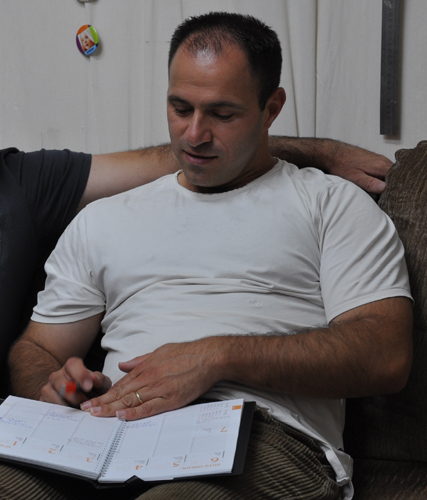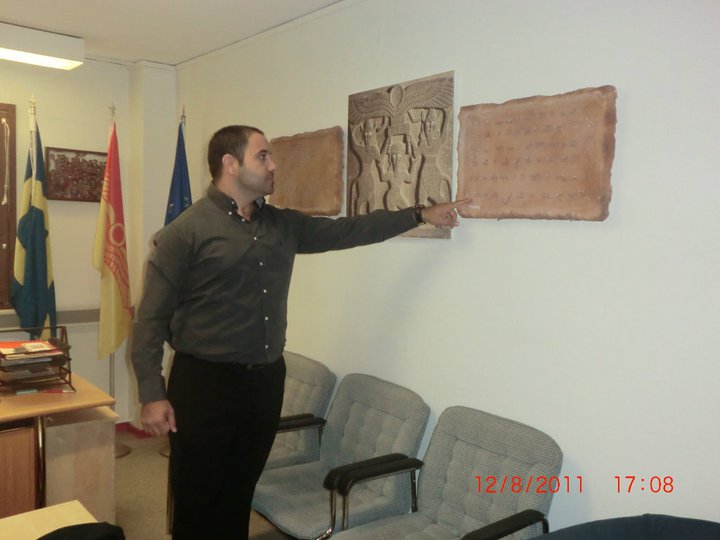|
Attempts to revive the Aramaic Language
in Israel by Maronites
The Ben Yehudas of Aramaic
|

Shady Khallul |

Amir Khallul |

Gush Halav
Haaretz israel news English
By Dorit Shilo
Israel news- Two Aramaic-language television stations in Sweden are
locked in a war for viewership among speakers of the ancient Middle
Eastern tongue. Devotees of Suroyo TV and Suryoyo Sat (both are
variations of the Aramaic word "Syriac," the Aramaic language) wage
heated online debates over which station is superior. The majority
preferSuroyo, the older station, and claim Suryoyo Sat copied much
of its content and broadcasts too many reruns. Some of the stations'
most avid viewers live in Israel, primarily in Haifa and the Galilee.
of the Upper Galilee village of Jish says, "What does
it matter which channel is better? The important thing is that they
exist.
These channels
prove that our Aramaic language lives and breathes." Aramaic is a
Semitic language related to Hebrew that was once spoken across the
Fertile Crescent. Over the centuries its influence has dwindled, and
today it is largely limited to a kind of coded and liturgical
language used by Middle Eastern Christians. The language is also
used by those who study Talmud, which is written in Aramaic.
Advertisement The language was widely believed to have become
extinct many years ago, but a number of dialects remain in use today
in large Aramaic-speaking communities in Syria, Iraq, Turkey and
Iran, and among smaller populations in Lebanon, Georgia, Azerbaijan
and Israel. Aramaic "diasporas" also exist in the United States and
Sweden, whose members not only speak the language but are at the
forefront of preserving it.
Aramaic speakers
are often referred to as Aramaeans, but also as ethnic Assyrians or
Syriacs depending on geography and preference. All told, over
400,000 people are believed to speak the language worldwide. Shady
Khallul and his brother Amir have been working for years to revive
the holy language of Aramaean Christians in Israel and to bring it
back into everyday use. Their model, Shady says, is none other than
Eliezer Ben Yehuda, father of the contemporary Hebrew language
renaissance. "If you, the Jews, were able to revive Hebrew and turn
it into a modern language, why can't we?" he asks. "Last year we
received permission from the Education Ministry to teach Aramaic in
first and second grades at the school in Jish, and we had to draft a
curriculum from scratch. Amir wrote the textbooks and I traveled
around the world to buy dictionaries and grammar books so that we
could translate and adapt them for use in Israel.
•
I brought most of
the teaching material from Sweden, and the dictionaries from France.
Most Aramaic books today are printed in Lebanon, but we have no way
of bringing them in from there." Unlike biblical Aramaic, written in
Hebrew letters, the modern dialect - the Western variant of which is
called Syriac - is written in another ancient script, which
resembles a melding of the Hebrew and Arabic alphabets. Like Hebrew,
the language comprises 22 characters and is written right to left.
Each of Aramaic's two principle dialects - Western and Eastern - has
its own alphabet. Both, however, share a classical written alphabet,
Estrangela, reserved for prayers and religious texts.
The challenge
before the Aramaeans in Israel, who use the Western dialect, is
twofold: On the one hand they must teach their children to speak the
language and persuade them to use it in their everyday lives, with
family, friends and at school, and on the other hand teach them to
read and write in the two alphabets (the Western and the Estrangela).
Jish was once the site of Gush Halav, a Jewish village in the Second
Temple period known for its fertile land and high-quality olive
groves. The site still houses the remains of an ancient synagogue,
as well as a Jewish cemetery which according to tradition holds the
tombs of the rabbinic sages Shamaya and Avtalion.
Modern Jish -
population 3,000 - sits on a mountaintop affording a breathtaking
view of the Upper Galilee. Thirty-five percent of its inhabitants
are Muslim and 10 percent are Greek Orthodox Christians; over half
are Maronite Christians, uprooted by the Israeli military from
neighboring Bir'am in the 1948 War of Independence and not allowed
to return (Kibbutz Bar'am now sits on some of the remains of the
village). The Maronites took root in the Fertile Crescent around 350
C.E. After the Arab conquest, they established an autonomous enclave
on Mount Lebanon, which fought for 0its existence for 1,400 years
and still struggles to keep its Aramaic heritage, language and
culture alive.
Aramaic Christian
literature largely developed between the third and eighth centuries
C.E. Learned Aramaeans translated Greek texts to Aramaic and then to
Arabic, making Aramaic into a kind of "pipeline" for transferring
Hellenistic ideas and science to the Arab world. Nonetheless, the
degeneration of Aramaic was inevitable with the invasion of the
Mamluks, a military ruling caste originating in Egypt. Gradually
Arabic not only superseded the everyday language, but also the
sacred tongue of the church. In 1517 the Maronites, still mostly
located in Lebanon, forged an alliance with the Druze in a bid to
shake off Mamluk rule. It was a prosperous, successful period for
both communities, as they regained their independence and retained
their cultural autonomy.
It was the
Aramaeans who created the mold for an expanded Lebanon as a state
for all its citizens regardless of creed, a feat they would later
regret as a historic mistake, as it converted them into minorities
in their own state. Precious connection The Maronite Christians in
Jish enjoy a vibrant community life and maintain close ties with
Maronites living elsewhere in Israel - mostly in Nazareth, Acre and
Haifa. These include 2,000 former South Lebanon Army soldiers who
sought refuge here after Israel's pullout from southern Lebanon in
2000. "When we first expressed the desire to teach Aramaic to
members of our community, the people of the village were very
enthusiastic," Khallul says. "Classes were immediately started at
the church in Jish, on Fridays for kids and Tuesdays for adults.
This year, after the Education Ministry approved the plan, people
got even more excited. Schoolchildren were given the choice of
studying Aramaic, and of 100 students in first and second grade, 64
chose Aramaic class instead of art and drawing."
He adds that the
school principal, who is Muslim, actively supports the project as
well. "Even her son chose to take the course, along with the son of
an old Muslim family in the village," Khallul notes. "The kids just
wanted to be in class with their friends, and their parents were
happy they would be learning about the culture and tradition of
their neighbors in the village." The word "tradition" is repeated in
this context by almost every Jish resident: To them, the Aramaic
language is vital to ensuring their continued existence as a people,
just as it is for Jews and Arabs. Students taking the course learn
not only basic phrases like "Safra taba, eichna itikun?" ("Good
morning, how are you?"), and "Halamna dil sgi shapira; it li sadvich
im shokolada" ("I am very well; I have a sandwich with chocolate"),
but also the Maronite liturgical tradition and the meaning of
Aramaic prayers.
On major holidays
like Christmas and Easter, young pupils bring their language skills
to church, having already mastered the prayers and hymns almost as
well as their elders. "We don't identify ourselves as an Aramaean
nation in contrast to other nations. We seek self-determination
alongside the Jews and the other minorities in this country,"
Khallul says. "The State of Israel is very precious to us - I am
very proud of my military combat service as a captain in the
Paratroopers Brigade, and no small number of Israeli Maronite
Aramaeans enlist in the Israel Defense Forces of their own free will,
in light of their support for the state. Our Aramaic language is
almost a twin sister to Hebrew, and we feel a tremendous, profound
feeling of belonging to this place, and all the traditions it holds."
The various Maronite streams in Lebanon were in constant contact
with the Zionist movement in Palestine from the 1930s onward. During
the 1939 Arab Revolt, Maronites provided food to the besieged Jews
of Safed by donkey, and smuggled Holocaust survivors through the
border crossing at Bir'am when the British closed Palestine to Jews
fleeing Europe. David Ben-Gurion even worked to establish a
Maronite
Christian state in Lebanon with Jewish Agency money, as part of his
vision of ushering in a new age in the Middle East. Jish recently
opened the Center for Maronite Accommodation in Gush Halav, where
residents offer Israelis and foreign visitors walking tours in the
area and visits to the ancient churches and synagogues, as well as
accommodation in local homes. The goal is not to open a chain of
bed-and-breakfasts where visitors go off to their own rooms, but to
invite families to a social and cultural meeting place where they
can become more familiar with the shared heritage of the region's
peoples. "All the people in the village joined up in operating the
center," Khallul says. "Everyone leaves happy after the encounter,
both hosts and visitors, who learn very quickly how to say in
Aramaic, 'Nahzor b'shlama, eloha nevarech lachun.' In other words, 'See
you later, God bless you.'" |